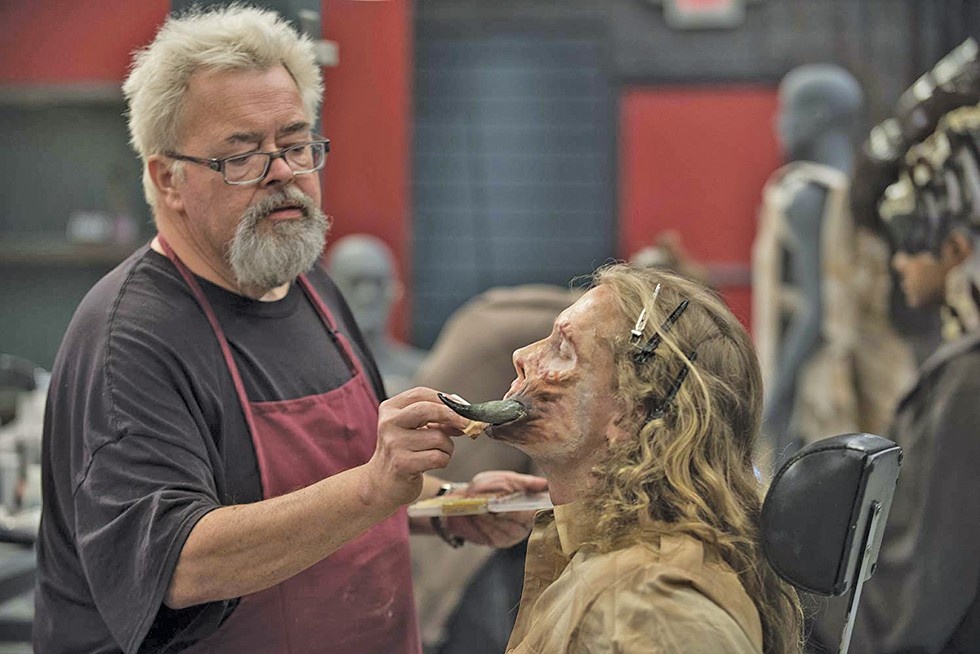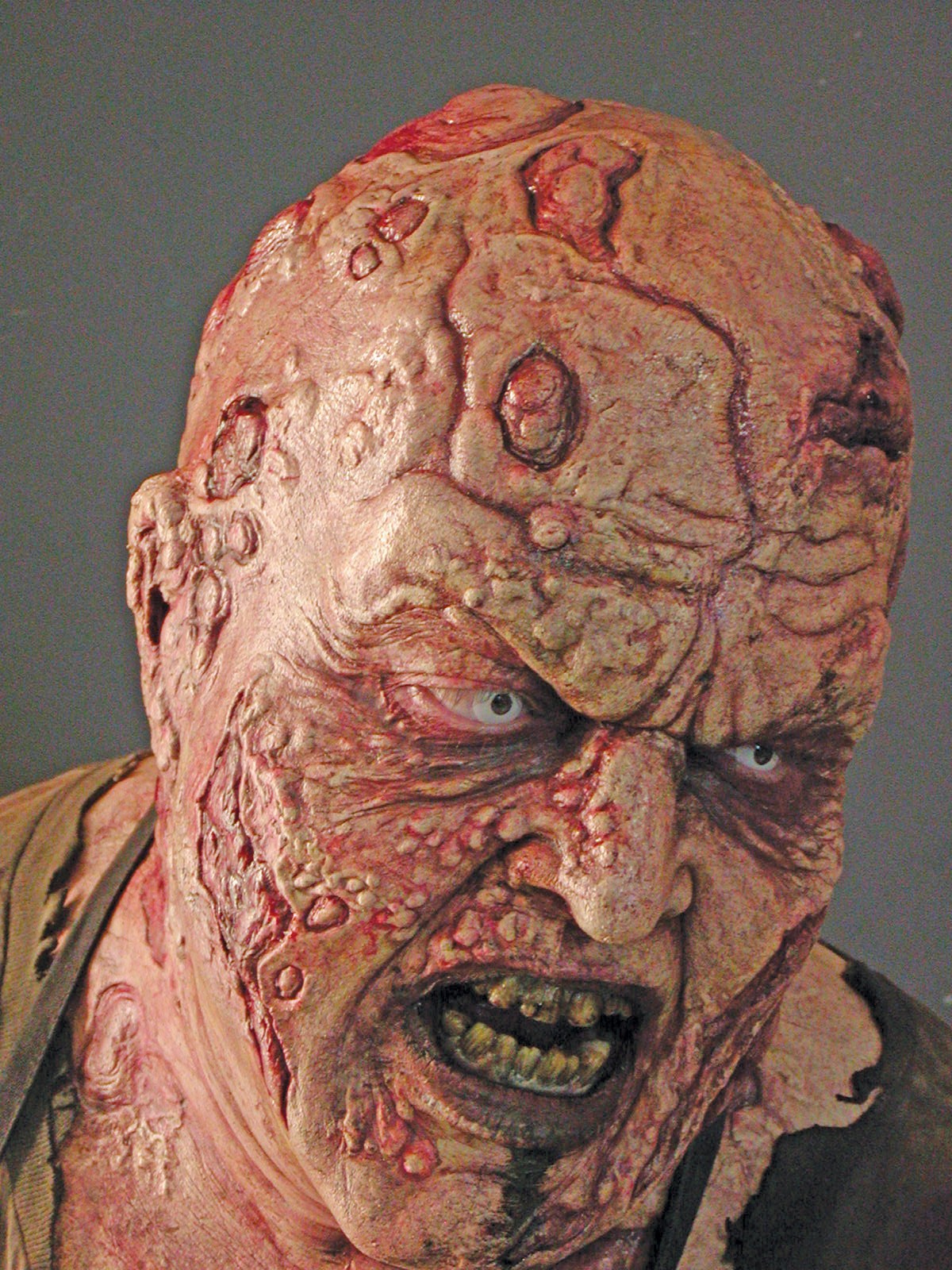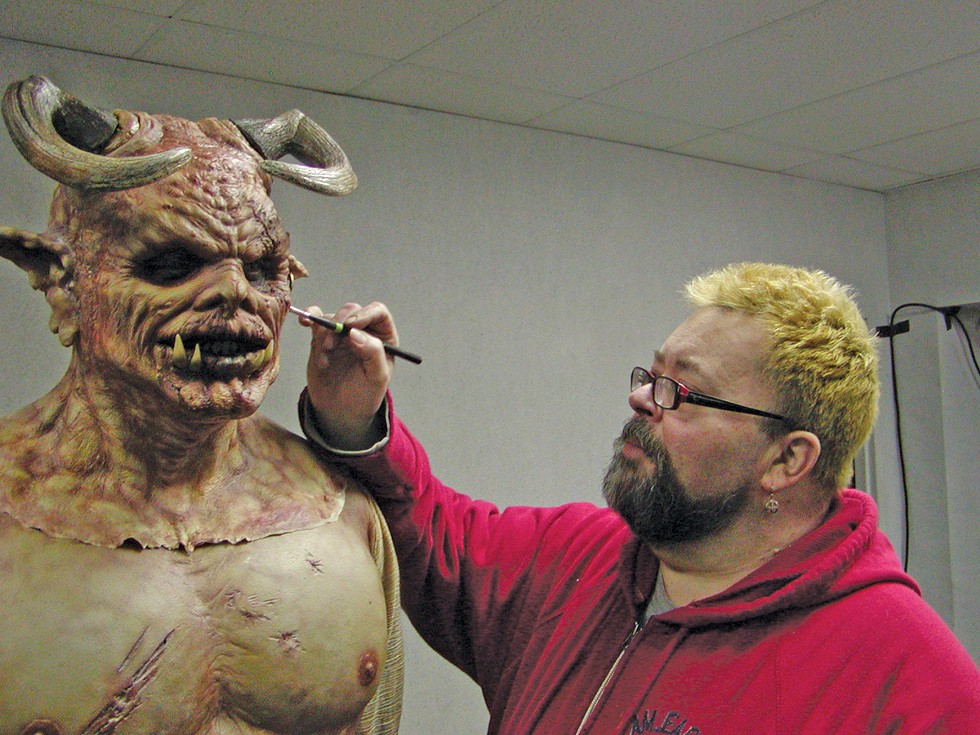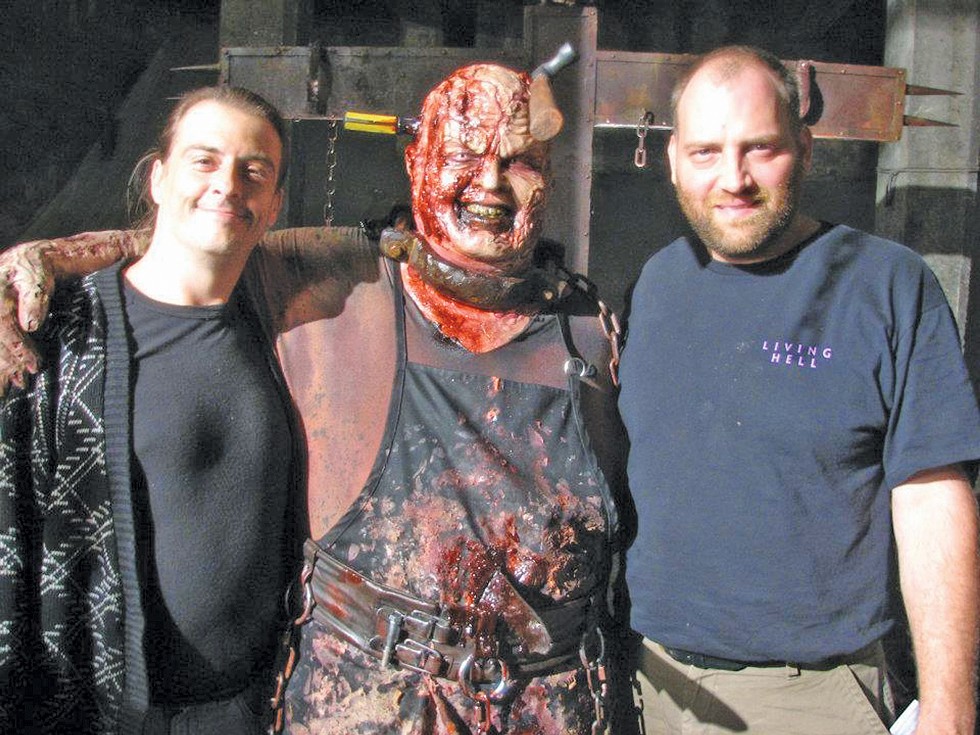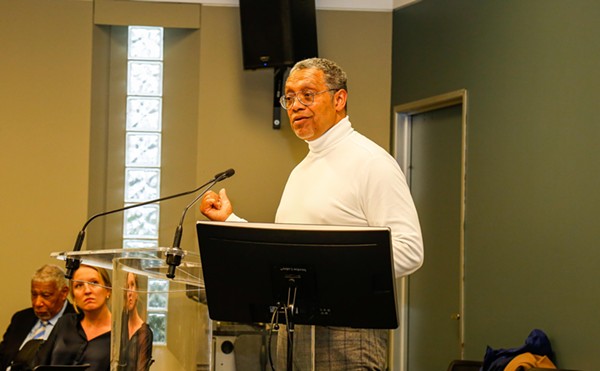"Alan did the weirdest thing with me you can do with another person: We turned a man into a walrus." — Kevin Smith
As a young boy, Alan Tuskes loved staying up late in his Westpark home to watch Ghoulardi, the legendary host of Shock Theater on Channel 8. The lab-coated hipster horror character, and the early classic science fiction and horror movies he introduced, were like nothing he'd ever seen.
If Ghoulardi and the black-and-white Universal flicks featuring goblins, monsters and aliens were a childhood introduction to new realms, H.G. Wells' The War of the Worlds was a full-on Technicolor baptism by fear.
"It absolutely scared the shit out of me," Tuskes, now 58, says. He remembers his parents finally letting him stay up past his bedtime one Friday night when he caught the film on one of the network channels.
"When I was growing up, the only thing on TV in color was the news, and War of the Worlds was in color; therefore, it was real," he says. The immediate aftermath involved a long talking-to by his parents to convince the panicked 9-year-old that it was just a movie; but a spark inside his brain was lit. From that moment forward, he wanted nothing more than to make his own monster movies.
"If you can make a movie and convince people that it's real, that's the coolest thing in the world, and I wanted to do that."
By his early teens, Tuskes was collecting every cent he earned from weekend dog-washing gigs to buy a movie camera, projector and everything he needed to create stop-motion Claymation like his hero, Ray Harryhausen.
"I was 12 years old, and I knew this is exactly what I wanted to do with my life," he says.
Every parent has heard the "When I grow up I'm gonna ..." speech — and probably more than one variation, based on whatever fleeting childhood interest has captured their kid's malleable and frenetic brain at any given moment. Some disappear as quickly as a summer vacation; some stick around as hobbies. Tuskes, though, was single-minded, much to his parents' concern.
"No, people from Ohio don't do that," he recalls them saying about his budding monster-making dreams. "Go to college and get a good career."
Unwilling to waver, Tuskes set out to convince them he could turn make-believe into reality. "This is what I wanted to do. I've never wanted to do anything else more in my life," he told them.
While some kids spent afternoons on the baseball diamond or tooling around town on bicycles, Tuskes would spend his covered in makeup, buried in library books on chemicals and molds, teaching himself how to sculpt, and devouring issues of Famous Monsters of Filmland magazine, which served as a makeup-effects bible. It was in those instructional pages he read about his idols, like an 18-year-old effects artist named Rick Baker who was working with foam latex. (Baker would later win the Academy Award for Best Makeup a record seven times, from a record 11 nominations, and was the inaugural winner of the award for his work on American Werewolf in London.)
During high school, where Tuskes excelled in science, advanced math, physics and chemistry, he and his friends would make amateur sci-fi films, learning the tricks of the trade — pyrotechnics, manipulating projectors to create lasers, set-building — through trial and error.
Tuskes may have been single-minded in his pursuit of a career in monster making, but for much of his early life that goal probably would have proved unreachable, adding up to nothing more than an elaborate and unique hobby. Not because he wouldn't one day be talented enough, but because those sorts of jobs simply didn't exist in large numbers. But the arrival of Star Wars changed everything for the industry, creating a huge demand for specialists in stop-motion, digital FX, robotics and special FX makeup on the back of the film's popularity. So his decision to head to Kent State University to study filmmaking on a scholarship after graduation didn't seem like the continuation of a far-fetched dream, but the next logical step in something that was concretely attainable.
"I spent every spare minute drawing, sculpting, molding, experimenting with chemicals, and getting better at these things," Tuskes says.
He was also looking at the art differently than a lot of his fellow students.
"There were a lot of Stan Brakhage types wanting to make non-narrative, flickering images, no story, black-and-white 'film as art;' but it's just like, it's pretty, but does it tell you anything? Do you make money on it? I suppose you can get a fellowship or a grant to make another one, but I wanted to tell stories."
Outside of school, he reached out to a production company in Kent that did commercials and industrials, hoping to get the chance to see how a real film production set ran. A week after his initial request, he was invited to work on an industrial as a spare hand on set, and they were offering a pay rate of $7 an hour.
For a strange college kid, that wasn't too shabby.
"I was getting to work on a film set and get paid for it? I was fucking ecstatic," he says.
Once he arrived on set, his bosses saw that Tuskes was clearly above and beyond what the company had expected. He brought with him a comprehensive knowledge of just about every technical aspect imaginable. Lighting, staging, gaffing, cinematography — Tuskes knew it all, and it impressed the hell out of them.
The question of what to do once he graduated lingered.
"Honestly, I really wanted to do what Savini did," Tuskes says.
Savini, for the uninitiated, is Tom Savini, one of the greatest special FX artists of all time, known for his makeup and special effects work on many films directed by George A. Romero, including Martin, Dawn of the Dead, Day of the Dead, Creepshow and Monkey Shines. He also created the special effects and makeup for cult classics like Friday the 13th (parts I and IV), Maniac, The Burning, The Prowler and The Texas Chainsaw Massacre 2.
Savini grew up in Pittsburgh, learned what he wanted to do, and was lucky enough to meet Romero, an ambitious filmmaker who needed his particular brand of expertise. Because of this connection, Savini was able to shoot films in Pittsburgh and stay in his hometown.
"I would have loved to have done that," says Tuskes. "I would have lived in Cleveland all my life if something like that could have happened back in the late '70s. It took a long time before that could start happening here, but that would have been perfect."
With the exception of 1966's The Fortune Cookie and 1970's Ghetto Freaks, Cleveland really didn't become a popular location for film productions until 1998, when the Greater Cleveland Film Commission was founded. But the city's burgeoning production scene was a long way off when Tuskes collected his diploma.
He continued working odd jobs, showing up whenever the production company needed an extra hand, but eventually his wife, Terry, suggested they admit what the next step had to be and take it. And with that, they moved to Hollywood.
"When I finally got there, I learned that the makeup shops are very departmentalized," he says.
Meaning, much like an assembly line, each person working in the shop is a master at one specific area. There's an expert mold-maker; there's someone who knows how to work air-brush painting better than anyone else; there's a dude who lives his every day manipulating foam latex.
"All you need to do is be good at one thing," he says, "but I came out there skilled in a lot of different areas, and I could do things that most people didn't know how to do, so I got a job pretty quickly."
Tuskes worked in smaller-scale shops, and then hooked up with a company known as the Chiodo Brothers. Formed by real-life brothers Stephen, Charles and Edward, the Chiodo brothers have brought to life iconic film characters like Large Marge in Pee-Wee's Big Adventure, the titular Critters, and created puppets and effects for films like Ernest Scared Stupid and Team America: World Police.
But back then, "we worked on a lot of kid shows, like, oh my god, some of them were so silly ... The Amazing Live Sea Monkeys, and Bananas in Pajamas, just all of these goofy kid shows," Tuskes says. While finishing up his work with the Chiodo Brothers, he got a call from Stan Winston Studios.
Who is Stan Winston? Well, he broke into mainstream prominence after working with Rob Bottin on John Carpenter's The Thing and would later create magic for the first three Jurassic Park films, Aliens, the first two Predator films, Inspector Gadget, Iron Man, The Monster Squad and Edward Scissorhands.
Two weeks after silly kid shows, Tuskes was working in the award-winning studio that brought the fucking Terminator to life.
Shops were increasingly impressed with his skill set, which put him on the radar of another Ohio-born FX artist, Robert Kurtzman, of KNB EFX group.
His tenure with KNB EFX included the TV mini-series Dune, which earned an Emmy for Best Special Effects, and major star-power and box-office hits including Austin Powers in Goldmember, Boogie Nights, From Dusk 'Til Dawn, Men in Black II, The Faculty, House on Haunted Hill, Little Nicky, The Green Mile, Unbreakable, Spy Kids, Thir13en Ghosts, Kill Bill Vol. 1 — and a little film called Pulp Fiction.
The industry was changing, and whereas young Tuskes would immerse himself in Famous Monsters of Filmland magazines, mid-career Tuskes dove into computer-generated imagery and digital FX to keep up with the latest techniques and technology of his trade.
"I never wanted to stop learning, and I never wanted to be afraid of changing or evolving with the landscape," he says.
That held true in his personal life as much as his professional life. Twenty years after they got married, and 15 years after they moved to Los Angeles, he and Terry finally decided to start a family.
"We were having the time of our lives and traveling, but right around the time Terry hit 40, she asked me, 'Hey, what about having a kid?'" he says. "And at this point, it had always been: No one impregnates the great and powerful Oz, not no how, not no way. Plus I, of course, was worried that all that shit they told us in the '70s about doing LSD and growing up to have six-armed babies with three eyes was true, but was hoping not."
Their first child, a boy, was followed two years later by a girl. Most of their relatives still lived in the Midwest, so "family" in Los Angeles became more communal than blood-related. Some of the most iconic monster makers in Hollywood became "Uncle Bob," "Uncle Howard" and "Uncle Greg."
In the FX business, being married and having kids is kind of like being the six-armed, three-eyed cousin at the dinner table. And that rarity begat a tradition amongst colleagues known as "The Chair."
"It was this old wooden high-chair," Tuskes says, "and whenever an FX artist got married and had children, it would be passed down from person to person, and we've all signed the underside of the tray. You could see a world of FX artists all brought together by our families. I'm sure it's still floating around, but I know I had to fix the peg legs myself at least three times."
While the adopted family of displaced FX artists brought together in sunny California by their love of movies was something Tuskes and his family treasured, they had their hearts and sights set back on Ohio, in Lakewood. They moved back: for the kids, for Tuskes and his college-era dream of living in Cleveland, and because the growth in the local film scene finally afforded him the chance to do special fx work in the city.
If it wasn't for the kids, there's a good chance Cleveland never would have gotten the gift of having him back, and his Los Angeles home, complete with a swimming pool, would still be his place of residence.
While he did work locally — for the past 14 years, Tuskes has often served as the Makeup Effects Shop supervisor and coordinator for Robert Kurtzman's Creature Corps and Precinct 13 Entertainment — his resume, relationships, and reputation as one of Hollywood's most sought-after artists in the game, meant he was still landing work outside the area. For example, there was Kevin Smith's cult-hit horror film Tusk.
"I'll never forget the insane attention to detail he paid to making Tusk," Kevin Smith tells Scene. "All through pre-production, he'd send me emails that, read out of context, were full of ghastly sentiments about body parts and blood. The man's a pro and a legend."
Arguably, some of Tuskes' best work was on the independent horror film You're Next from Adam Wingard and Simon Barrett (Blair Witch, A Horrible Way to Die, V/H/S), and it all came about on super short notice.
"My buddy called me up and goes, 'Hey, so there's a couple of throat slashes, a woman runs into a wire and gets her throat cut, a guy gets a blender to the head ... do you think you could do that?'" Tuskes says. That call was on a Thursday. He was on set by Sunday.
On a low-budget set, with some of the most passionate budding filmmakers in genre creation, (Wingard would go on to make Death Note for Netflix and is set to direct the upcoming Godzilla vs. Kong), Tuskes shattered the filmmakers' expectations.
"He did amazing work. It was one of my first times working with a true SFX professional," says writer and actor Simon Barrett. "Ultimately, Alan's work on making my face look like the back of my head had been bludgeoned with a meat tenderizer was so good that Adam [Wingard] and I both felt a little guilty it was only going to be shown on screen for a split second, especially since it took nearly an hour to apply. But that's the thing about great makeup effects: Just because they hold up to scrutiny doesn't mean the camera should dwell on them. If something feels fully real, you have the option to film it like you would anything else, and that's what Alan gave us with that effect."
Since moving back to Cleveland, Tuskes has been on the frontlines of just about everything that's come through town thanks to Ohio's tax incentive, including Kill the Irishman, Native Son, The Last Summer, White Boy Rick and All the Bright Places starring Elle Fanning, which is currently shooting in Elyria.
In the summer of 2017, Tuskes stepped in front of the camera for the first time, competing on Syfy's special effects makeup competition/reality show, Face Off.
As the landscape of film production has changed thanks to technology, so has the realm of special fx makeup. In both cases, there are downsides along with the upsides.
On the makeup front, Tuskes is fearful that a generation raised on Instagram tutorials and beauty blogging is diluting the industry.
"So many of these so-called 'designs' may look nicely in one angle in front of one type of camera, but it's just not practical for real-world execution," he says. "No one is ever going to have a zipper face or half of a Coke can jabbed in their head, but if you look up these makeup tutorials on Instagram or wherever, it's all you see."
And many of those, he says, are just garbage.
"Everyone wants to be a special FX makeup artist but because of the internet, there's so much information and so much of it is just bad," he says. "You have to have initiative to make it work in this industry. I'm sure if you figure out how to do a nice Coke can in the head you'll get a hundred thousand hits, but it's not going to get you a job on a film set. Don't do what everyone else on the internet is doing. Make something unique. Stand out."
As for the widely accessible, and affordable, advancements in technology, from editing programs to camera phones, they might translate to making movies easier than ever, but they also mean the market has never been more saturated, thanks in part to downright awful flicks easily distributed on Amazon Prime or YouTube for mass consumption.
"Sometimes I worry about the low-budget, independent films coming out of Cleveland," Tuskes says. "We have CIFF (Cleveland International Film Festival), but then we have these smaller-run festivals that advertise themselves as 'international film festivals' that give out awards to films that use in-camera audio and were shot on whatever was the best camera they could get at a Best Buy for a few hundred bucks — and this is supposed to represent our city."
Fortunately, there are plenty of incredible films shot in Cleveland, a location Tuskes thinks is perfect for the industry. "I love seeing films shot in Cleveland, because it's like a city lost in time. We get all four seasons, and we've never burned down."
Cleveland has stood in for major metropolitan cities, middle-of-nowhere Midwest towns and just about everything in between.
"It's great, because Cleveland is also such a welcoming city to film crews because it's still so novel. In the coastal cities, people are so jaded by the process," he says. "Clevelanders are ecstatic to help out, they view [film shoots] as a cause for celebration, not an inconvenience, and it's reasons like that, that made me never want to leave in the first place."
Of course, working in an area that isn't as familiar with the filmmaking process does have its difficulties and peculiarities, especially for someone in Tuskes' role.
"I once had a police officer show up at my house because a fake foot covered in corn syrup had started to mold and looked like a severed body was stored in my trash," he says. There was also the time he made eye-contact with a police officer at a gas station while driving home from a set with a back seat full of body parts and a fake body wrapped in plastic tied to the roof of his car, not unlike dead Aunt Edna in Vacation.
"I thought the cop would say something to me, because I know he saw it, but he just smiled and nodded," Tuskes chuckles. "If he thought it was real, he probably didn't want to fuck with the guy openly carrying a dead body on the roof of his car."

